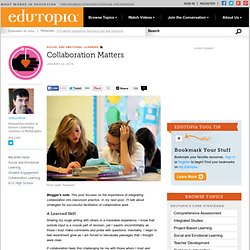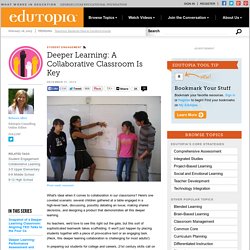

Classroom collaboration service. Collaboration Matters. Blogger's note: This post focuses on the importance of integrating collaboration into classroom practice.

In my next post, I'll talk about strategies for successful facilitation of collaborative work. A Learned Skill Sharing my rough writing with others is a miserable experience. I know that outside input is a crucial part of revision, yet I squirm uncomfortably as those I trust make comments and probe with questions. Inevitably, I begin to feel resentment grow as I am forced to reevaluate passages that I thought were clear. If collaboration feels this challenging for me with those whom I trust and respect, it must feel even harder for my students because: I often make a point of dividing them into heterogeneous groups that include students with different skill levels.The projects I assign require agreement and coordination between all the members of a group.I expect the final products to be polished and ready for a wider audience.
Starting the Year on a Positive Note. Back in May, I asked readers to think of five things they'd done well over the last school year.

I followed it up with a post on my personal blog reflecting on what I thought I did well. Now it's time for the school year to rev up again, and I'm hoping to not only keep doing what I did well, but also set some goals for the coming year. As this blog is a tech integration blog, I want you to think about something you want to do better or something new you want to try this year. As I have stated in many previous posts, the worst thing you can do when trying to bring new technology into your classroom, whether it be a simple web-based tool or a piece of hardware, is try to do too much. With the proliferation of Web 2.0 tool lists, blogs about successes teachers have had with particular endeavors, webinars, wikis, online communities and more, it can be easy to get overwhelmed.
Benefits Of Collaborative Teaching For Interdisciplinary Learning. Deeper Learning: A Collaborative Classroom is Key. What's ideal when it comes to collaboration in our classrooms?

Here's one coveted scenario: several children gathered at a table engaged in a high-level task, discussing, possibly debating an issue, making shared decisions, and designing a product that demonstrates all this deeper learning. As teachers, we'd love to see this right out the gate, but this sort of sophisticated teamwork takes scaffolding. It won't just happen by placing students together with a piece of provocative text or an engaging task. (Heck, this deeper learning collaboration is challenging for most adults!) In preparing our students for college and careers, 21st century skills call on us to develop highly collaborative citizens -- it's one of the 4 Cs, after all. So how do we begin this scaffolded journey? Establish Group Agreements. Collaborative Learning Builds Deeper Understanding. 21st century classroom design cultivates collaboration. Collaborative Teaching for Special Education Students.
Updated July 02, 2014.

Collaborative Teaching in Special Education Programs: Collaboration means providing special education in regular education classrooms. Today, more special education students are taught in regular classrooms, and collaboration is increasing. Collaboration helps to ensure children with learning disabilities get a free appropriate public education, including specialized instruction, in a regular classroom.
There are several ways to ensure students get the instructional support they need. Collaboration Models - The Lead Teacher Model: In classrooms with a lead teacher, often the regular classroom teacher delivers the instruction in the subject area. Collaboration Models - Stations or Centers: Each teacher is responsible for instruction in a specific area of the room. Resource Services, or Alternative Collaborative Setting: Collaboration Models - Team Teaching:
Emerging Trends in Education : Collaborative Tools and Technology. Ways To Make Teacher Peer Review More Effective. Teacher Collaboration Strategies For CCSS And ELLs. Strategies To Analyze Author Choices. Librarian and Classroom Teacher Collaboration. Web 2.0 Collaborative Learning Resources. MindMaps - Collaborative Tools. 3 Great Tools for Collaborative Brainstorming. Collaboration is an essential feature of the 21st century education.

Students are encouraged to work together and benefit from their collective wisdom.There are several ways teachers can use to foster collaborative habits among their students and most important of them all is through group work or classroom group projects. While working together, students get to discover different ways of thinking other than theirs and they also share and build a healthy learning environment. Working together on projects does require pulling ideas from different resources and this is probably one of the problematic things about collaborative brainstorming. However, there are now several excellent web tools that students can use to collectively brainstorm a topic. Below are some of the titles I recommend the most to students and teachers. 1- Real Time Board This is a web tool I have already reviewed in an earlier post here in this blog. 2- Lucid Chart 3- Spider Scribe.